Cherry Blossom
RSP 11323
Grower: Yabba Cannaba
General Information
- Sample Name
- CI5
- Accession Date
- October 17, 2019
- Reported Plant Sex
- Female
- Report Type
- StrainSEEK v2 3.2Mb
- DNA Extracted From
- Stem
The strain rarity visualization shows how distant the strain is from the other cultivars in the Kannapedia database. The y-axis represents genetic distance, getting farther as you go up. The width of the visualization at any position along the y-axis shows how many strains there are in the database at that genetic distance. So, a common strain will have a more bottom-heavy shape, while uncommon and rare cultivars will have a visualization that is generally shifted towards the top.
Chemical Information
Cannabinoid and terpenoid information provided by the grower.
Cannabinoids
No information provided.
Terpenoids
No information provided.
Genetic Information
- Plant Type
- Type III
File Downloads
The bell curve in the heterozygosity visualization shows the distribution of heterozygosity levels for cannabis cultivars in the Kannapedia database. The green line shows where this particular strain fits within the distribution. Heterozygosity is associated with heterosis (aka hybrid vigor) but also leads to the production of more variable offspring. When plants have two genetically different parents, heterozygosity levels will be higher than if it has been inbred or backcrossed repeatedly.
The ratio of reads mapped to Y-contigs to reads mapped to the whole Cannabis genome (Y-ratios) has been demonstrated to be strongly correlated with plant sex typing. This plot shows the distribution of Y-ratios for all samples in our database which were sequenced with the same method (panel or WGS) as this sample and where this sample falls in the distribution.
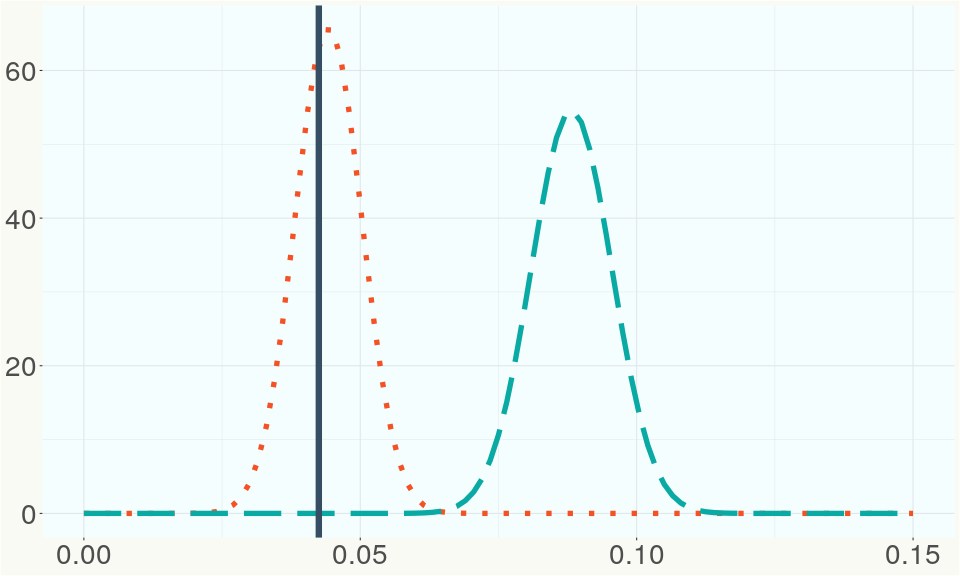
This chart represents the Illumina sequence coverage over the Bt/Bd allele. These are the three regions in the cannabis genome that impact THCA, CBDA, CBGA production. Coverage over the Active CBDAS gene is highly correlated with Type II and Type III plants as described by Etienne de Meijer. Coverage over the THCA gene is highly correlated with Type I and Type II plants but is anti-correlated with Type III plants. Type I plants require coverage over the inactive CBDA loci and no coverage over the Active CBDA gene. Lack of coverage over the Active CBDA and Active THCA allele are presumed to be Type IV plants (CBGA dominant). While deletions of entire THCAS and CBDAS genes are the most common Bt:Bd alleles observed, it is possible to have plants with these genes where functional expression of the enzyme is disrupted by deactivating point mutations (Kojoma et al. 2006).
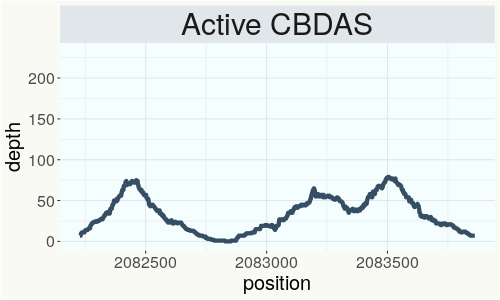
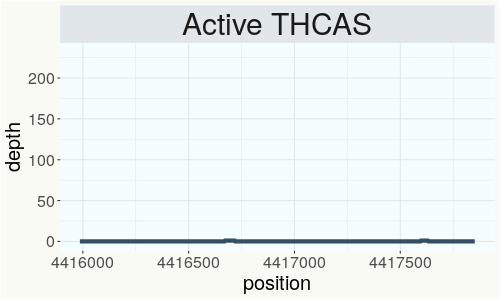
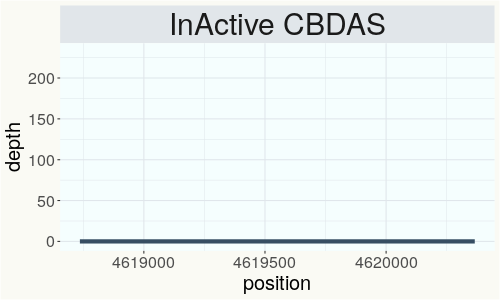
This chart represents the Illumina sequence coverage over the CBCA synthase gene.
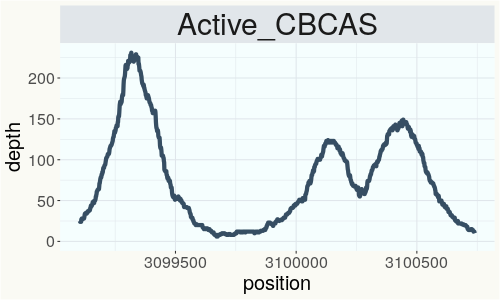
Variants (THCAS, CBDAS, and CBCAS)
No variants to report
Variants (Select Genes of Interest)
| PKSG-4a | c.493G>A | p.Gly165Ser | missense variant | moderate | contig700 | 1937904 | G/A |
|
| PKSG-4a |
c.1191_1193d |
p.Tyr398del | disruptive inframe deletion | moderate | contig700 | 1938600 | AATT/A |
|
| PKSG-2b | c.1117A>G | p.Ile373Val | missense variant | moderate | contig700 | 1950521 | T/C | |
| PKSG-4b | c.496A>G | p.Lys166Glu | missense variant | moderate | contig700 | 2721177 | T/C | |
| PKSG-4b | c.489delT | p.Phe163fs | frameshift variant | high | contig700 | 2721183 | CA/C | |
| PKSG-4b | c.485A>G | p.Lys162Arg | missense variant | moderate | contig700 | 2721188 | T/C | |
| PKSG-4b |
c.352_355del |
p.Thr118fs | frameshift variant | high | contig700 | 2721317 | CCTGT/C |
|
| PKSG-4b | c.324A>C | p.Glu108Asp | missense variant | moderate | contig700 | 2721349 | T/G |
|
| PKSG-4b | c.323A>G | p.Glu108Gly | missense variant | moderate | contig700 | 2721350 | T/C |
|
| aPT4 | c.97T>C | p.Tyr33His | missense variant | moderate | contig121 | 2828753 | T/C |
|
| aPT4 | c.153A>C | p.Lys51Asn | missense variant | moderate | contig121 | 2828809 | A/C |
|
| aPT4 |
c.235_236del |
p.Val79fs | frameshift variant | high | contig121 | 2829030 | ATG/A |
|
| aPT4 | c.238delT | p.Ser80fs | frameshift variant | high | contig121 | 2829034 | AT/A |
|
| aPT4 | c.302A>G | p.Asn101Ser | missense variant | moderate | contig121 | 2829099 | A/G |
|
| aPT4 |
c.744+1_744+ |
splice donor variant & splice region variant & intron variant | high | contig121 | 2831022 |
GGTAATTTATTT |
|
|
| HDS-2 |
c.82_93delGT |
p.Val28_Thr3 |
conservative inframe deletion | moderate | contig95 | 1989748 |
CGTAACCGGAAC |
|
| HDS-2 | c.127T>G | p.Ser43Ala | missense variant | moderate | contig95 | 1989794 | T/G |
|
Nearest genetic relatives (All Samples)
- 0.198 Cherry Blossom (RSP11327)
- 0.227 Cherry Blossom (RSP11274)
- 0.232 Cherry Blossom (RSP11321)
- 0.251 Cherry Blossom (RSP11334)
- 0.256 Unknown--Cherry Wine---001- (RSP11268)
- 0.257 Cherry Blossom (RSP11318)
- 0.257 Cherry Blossom (RSP11301)
- 0.261 Cherry Blossom (RSP11299)
- 0.266 Cherry Blossom (RSP11331)
- 0.273 Cherry Blossom CBG (RSP11303)
- 0.287 Queen Dream CBG (RSP11277)
- 0.289 Queen Dream (RSP11289)
- 0.295 Cherry Blossom (RSP11315)
- 0.296 Cherry Blossom (RSP11302)
- 0.303 Cherry Blossom (RSP11328)
- 0.304 Cherry Blossom (RSP11322)
- 0.309 Cherry Blossom (RSP11330)
- 0.309 Queen Dream (RSP11288)
- 0.313 Cherry Blossom (RSP11298)
- 0.313 Unknown--Cherry Wine---002- (RSP11269)
Most genetically distant strains (All Samples)
- 0.536 White Label 1 (RSP11336)
- 0.522 Cherry (RSP11142)
- 0.512 RKM-2018-022 (RSP11114)
- 0.493 Cherry Blossom (RSP11300)
- 0.493 80E (RSP11211)
- 0.491 80E (RSP11213)
- 0.491 80E (RSP11212)
- 0.490 Strawberry Cough (RSP11356)
- 0.488 NSPM x NSPM (RSP11487)
- 0.486 Big Bud (RSP11221)
- 0.485 BagSeed (RSP12627)
- 0.485 JL Cross 6 (RSP11507)
- 0.484 RKM-2018-026 (RSP11118)
- 0.483 R3in134 (SRR14708220)
- 0.483 Fatso (RSP11741)
- 0.482 White Chronic (RSP11220)
- 0.481 Green Crack (RSP12099)
- 0.481 Eran Almog 05MAY2017 (RSP10937)
- 0.480 Right Mark (RSP11628)
- 0.480 Strawberry (RSP12095)
Nearest genetic relative in Phylos dataset
- Overlapping SNPs:
- 63
- Concordance:
- 40
Nearest genetic relative in Lynch dataset
- Overlapping SNPs:
- 7
- Concordance:
- 7
Blockchain Registration Information
- Transaction ID
-
ad0115ce868ba142
11b8c02d24228d42 9cd96e51862839b6 04016ecc235877c5 - Stamping Certificate
- Download PDF (855.4 KB)
- SHASUM Hash
-
ebfa12c8bdc7a9d402eb7493c5f59e57 412409544e86fb80 0120a17ef6e9d71a